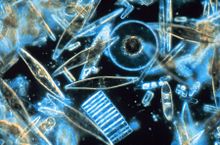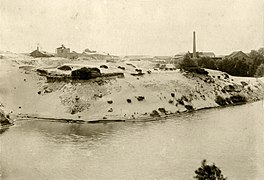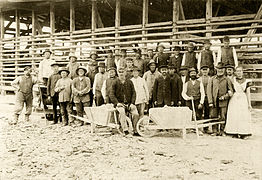Diatomaceous earth


Diatomaceous earth (
Diatomaceous earth consists of the fossilized remains of diatoms, a type of hard-shelled microalgae.[3] It is used as a filtration aid, mild abrasive in products including metal polishes and toothpaste, mechanical insecticide, absorbent for liquids, matting agent for coatings, reinforcing filler in plastics and rubber, anti-block in plastic films, porous support for chemical catalysts, cat litter, activator in coagulation studies, a stabilizing component of dynamite, a thermal insulator, and a soil for potted plants and trees as in the art of bonsai.[4][5] It is also used in gas chromatography packed columns made with glass or metal as stationary phase.
Composition
Each deposit of diatomaceous earth is different, with varying blends of pure diatomaceous earth combined with other natural clays and minerals.
Many deposits throughout British Columbia, such as Red Lake Earth, are from the Miocene epoch and contain a species of diatom known as Melosira granulata. These diatoms have a small globular shape. A deposit containing diatoms from this epoch can provide certain benefits over others. For example, diatoms from the Eocene epoch are not as effective in their ability to absorb fluids because as older diatoms recrystallize, their small pores become filled with silica.[6]
Formation
| Part of a series related to |
| Biomineralization |
|---|
 |
Diatomite forms by the accumulation of the
Diatoms are able to extract silica from water that is less than 1% saturated in amorphous silica (saturation index (SI): -2). Their frustules remain undissolved because they are surrounded by an organic matrix. Clay minerals may also precipitate on the frustules and protect them from dissolution in sea water. When the diatom dies, the frustule is stripped of its organic layer and exposed to sea water. As a result, only 1% to 10% of frustules survive long enough to be buried under sediments and some of this is dissolved within the sediments. Only an estimated 0.05% to 0.15% of the original amount of silica produced by diatoms is preserved in the sedimentary record.[8]
Discovery
In 1836 or 1837, German peasant Peter Kasten discovered diatomaceous earth (German: Kieselgur) when sinking a well on the northern slopes of the Haußelberg hill, on Lüneburg Heath in North Germany.[9][10]
The extraction site on Lüneburg Heath was 1863–1994 Neuohe, while the storage sites were:
| Storage site | from | to |
|---|---|---|
| Wiechel | 1871 | 1978 |
| Hützel | 1876 | 1969 |
| Hösseringen | c. 1880 | 1894 |
| Hammerstorf | c. 1880 | 1920 |
| Oberohe | 1884 | 1970 |
| Schmarbeck | 1896 | c. 1925 |
| Steinbeck | 1897 | 1928 |
| Breloh | 1907 | 1975 |
| Schwindebeck | 1913 | 1973 |
| Hetendorf | 1970 | 1994 |
The deposits are up to 28 meters (92 ft) thick and are all of freshwater diatomaceous earth.[citation needed]
-
c. 1900–1910 Diatomaceous earth pit at Neuohe
-
c. 1900–1910 a drying area: One firing pile is being prepared; another is under way.
-
1913: Staff at the Neuohe factory, with male workers and a female cook in front of a drying shed
Until World War I, almost the entire worldwide production of diatomaceous earth was from this region.[citation needed]
Other deposits
In Poland diatomaceous earth deposits are found in Jawornik, and are composed mostly of diatomaceous skeletons (frustules).[11]
In Germany, diatomaceous earth was also extracted at Altenschlirf[12] on the Vogelsberg (Upper Hesse) and at Klieken[13] (Saxony-Anhalt).
There is a layer of diatomaceous earth more than 6 meters (20 ft) thick in the nature reserve of Soos in the Czech Republic.[14]
Deposits on the Isle of Skye, off the west coast of Scotland, were mined until 1960.[15]
In
Diatomaceous earth is sometimes found on desert surfaces. Research has shown that the erosion of diatomaceous earth in such areas (such as the Bodélé Depression in the Sahara) is one of the most important sources of climate-affecting dust in the atmosphere.[18]
The siliceous
in Iceland.The commercial deposits of diatomite are restricted to Tertiary or Quaternary periods. Older deposits from as early as the Cretaceous Period are known, but are of low quality.[17]
Diatomite deposits rich in fossils have been located in New Zealand, but mining of the Foulden Maar deposits on an industrial scale, for conversion to animal feed, has drawn strong opposition.[20]
Commercial form
Diatomaceous earth is available commercially in several formats:
- granulateddiatomaceous earth is a raw material simply crushed for convenient packaging
- micronizeddiatomaceous earth is especially fine (10 μm to 50 μm) and used for insecticides.
- calcineddiatomaceous earth is heat-treated and activated for filters.


Usage
Explosives
In 1866, Alfred Nobel discovered that nitroglycerin could be made much more stable if absorbed in diatomite (kieselguhr).[21] This allowed a much safer transport and handling than pure nitroglycerin under the liquid form. Nobel patented this mixture as dynamite in 1867; the mixture is also called guhr dynamite by reference to the German term kieselguhr.[22]
Filtration
The Celle engineer, Wilhelm Berkefeld, recognized the ability of the diatomaceous earth to filter and developed tubular filters (known as filter candles) fired from diatomaceous earth.[23] During the cholera epidemic in Hamburg in 1892, these Berkefeld filters were used successfully. One form of diatomaceous earth is used as a filter medium, especially for swimming pools. It has a high porosity because it is composed of microscopically small, hollow particles. Diatomaceous earth (sometimes referred to by trademarked brand names such as Celite) is used in chemistry as a filtration aid, to increase flow rate, and filter very fine particles that would otherwise pass through or clog filter paper. It is also used to filter water, particularly in the drinking water treatment process and in fish tanks, and other liquids, such as beer and wine. It can also filter syrups, sugar, and honey without removing or altering their color, taste, or nutritional properties.[24]
Abrasive
The oldest use of diatomite is as a very mild abrasive and has been used in toothpaste, metal polishes, and some facial scrubs.
Pest control
Diatomite is of value as an insecticide because of its abrasive and physico-sorptive properties.[25] The fine powder adsorbs lipids from the waxy outer layer of the exoskeletons of many species of insects; this layer acts as a barrier that resists the loss of water vapour from the insect's body. Damaging the layer increases the evaporation of water from their bodies, so that they dehydrate, often fatally.
This also works against
The shape of the diatoms contained in a deposit has not been proven to affect their functionality when it comes to the adsorption of lipids; however, certain applications, such as that for slugs and snails, do work best when a particularly shaped diatom is used, suggesting that lipid adsorption is not the only factor involved. For example, in the case of slugs and snails, large, spiny diatoms work best to lacerate the epithelium of the mollusk. Diatom shells will work to some degree on the vast majority of animals that undergo
Diatomaceous earth is widely applied for insect control in grain storage.[30]
In order to be effective as an insecticide, diatomaceous earth must be uncalcinated (i.e., it must not be heat-treated prior to application)[31] and have a mean particle size below about 12 μm (i.e., food grade—see below).
Although considered to be relatively low-risk, pesticides containing diatomaceous earth are not exempt from regulation in the United States under the
Thermal
Its thermal properties enable it to be used as the barrier material in some fire-resistant safes.[citation needed] It is also used in evacuated powder insulation for use with cryogenics.[33] Diatomaceous earth powder is inserted into the vacuum space to aid in the effectiveness of vacuum insulation. It was used in the classical AGA cookers as a thermal heat barrier.[citation needed]
Catalyst support
Diatomaceous earth also finds some use as a
Agriculture
Natural freshwater diatomaceous earth is used in agriculture for grain storage as an anticaking agent, as well as an insecticide.[35] It is approved by the Food and Drug Administration as a feed additive[36] to prevent caking.[37]
Some believe it may be used as a natural anthelmintic (dewormer), although studies have not shown it to be effective.[26][27] Some farmers add it to their livestock and poultry feed to prevent the caking of feed.[38] "Food-Grade Diatomaceous Earth" is widely available in agricultural feed supply stores.
Freshwater diatomite can be used as a growing medium in
It is also used as a growing medium in potted plants, particularly as bonsai soil. Bonsai enthusiasts use it as a soil additive, or pot a bonsai tree in 100% diatomaceous earth. In vegetable gardening it is sometimes used as a soil conditioner, because like perlite, vermiculite, and expanded clay, it retains water and nutrients, while draining fast and freely, allowing high oxygen circulation within the growing medium.
Marker in livestock nutrition experiments
Natural dried, not calcinated diatomaceous earth is regularly used in livestock nutrition research as a source of acid-insoluble ash (AIA), which is used as an indigestible marker. By measuring the content of AIA relative to nutrients in test diets and feces or digesta sampled from the terminal ileum (last third of the small intestine) the percentage of that nutrient digested can be calculated using the following equation:
where:
Natural freshwater diatomaceous earth is preferred by many researchers over chromic oxide, which has been widely used for the same purpose, the latter being a known carcinogen and, therefore, a potential hazard to research personnel.
Construction
Spent diatomaceous earth from the brewing process can be added to ceramic mass for the production of red bricks with higher open porosity.[39]
Diatomaceous earth is considered a very prominent inorganic non-metallic material that can be used for the production of various ceramics, including production of porous ceramics under low temperature hydrothermal technology.[40]
Specific varieties
- Tripolite is the variety found in Tripoli, Libya.
- Bann clay is the variety found in the Lower Bannvalley in Northern Ireland.
- Moler (mo-clay) is the variety found in northwestern Denmark, especially on the islands of Fur and Mors.
- Freshwater-derived food grade diatomaceous earth is the type used in United States agriculture for grain storage, as feed supplement, and as an insecticide. It is produced uncalcinated, has a very fine particle size, and is very low in crystal silica (<2%).
- Salt-water-derived pool / beer / wine filter grade is not suitable for human consumption or effective as an insecticide. Usually calcinatedbefore being sold to remove impurities and undesirable volatile contents, it is composed of larger particles than the freshwater version and has a high crystalline silica content (>60%).
Microbial degradation
Certain species of bacteria in oceans and lakes can accelerate the rate of dissolution of silica in dead and living diatoms by using
Climatologic importance
The Earth's climate is affected by dust in the atmosphere, so locating major sources of atmospheric dust is important for climatology. Recent research indicates that surface deposits of diatomaceous earth play an important role. Research shows that significant dust comes from the Bodélé Depression in Chad, where storms push diatomite gravel over dunes, generating dust by abrasion.[43]
Safety considerations
Inhalation of crystalline silica is harmful to the lungs, causing
The crystalline silica content of diatomaceous earth is regulated in the United States by the Occupational Safety and Health Administration (OSHA) and there are guidelines from the National Institute for Occupational Safety and Health that set maximum amounts allowable in the product (1%) and in the air near the breathing zone of workers, with a recommended exposure limit at 6 mg/m3 over an 8-hour workday.[47] OSHA has set a permissible exposure limit for diatomaceous earth as 20 mppcf (80 mg/m3/%SiO2). At levels of 3,000 mg/m3, diatomaceous earth is immediately dangerous to life and health.[48]
In the 1930s, long-term occupational exposure among workers in the cristobalite diatomaceous earth industry who were exposed to high levels of airborne crystalline silica over decades were found to have an increased risk of silicosis.[49]
Diatomite produced for pool filters is treated with high heat (
See also
- Aerogel – Synthetic ultralight solid material
- Biomineralization – Process by which living organisms produce minerals
- Fuller's earth – Any clay material that can decolorise oil or other liquids
- Perlite – Amorphous volcanic glass
- Rock flour – Glacier-generated sediment
- Siliceous ooze – Biogenic pelagic sediment located on the deep ocean floor
- Zeolite – Microporous, aluminosilicate mineral
References
- PMID 35629631.
- ^ a b Antonides, Lloyd E. (1997). Diatomite (PDF). USGS. Retrieved December 12, 2010.
- ^ S2CID 23110767.
- .
- ^ Reka, Arianit; Anovski, Todor; Bogoevski, Slobodan; Pavlovski, Blagoj; Boškovski, Boško (December 29, 2014). "Physical-chemical and mineralogical-petrographic examinations of diatomite from deposit near village of Rožden, Republic of Macedonia". Geologica Macedonica. 28 (2): 121–126.
- ^ "Diatoms". UCL London's Global University. Retrieved September 14, 2011.
- ISBN 0131547283.
- ISBN 0136427103.
- S2CID 202096365.
- ^ Klebs, Florian (December 17, 2001). "Deutschland - Wiege des Nobelpreis: Tourismus-Industrie und Forschung auf den Spuren Alfred Nobels" (in German). Alexander von Humboldt Foundation. Archived from the original on November 17, 2002. Retrieved October 12, 2018.
- .
- ^ "Was ist es um die Kieselgur?". Archived from the original on September 28, 2007. Retrieved March 10, 2010. Über den früheren Abbau von Kieselgur im Vogelsberg/Hessen
- ^ Geschichte des Kieselgurabbaus in Klieken Archived April 20, 2008, at the Wayback Machine
- ^ "Protokol o vypořádání připomínek a schválení plánu péče NPR Soos na období 2016–2023" [Protocol on the settlement of comments and approval of the NPR Soos care plan for the period 2016-2023] (in Czech). Ministerstvo životního prostředí [Ministry of the Environment]. February 1, 2016. p. 13. Retrieved April 5, 2021.
- ^ "Skye diatomite: A lost industry". www.stornowaygazette.co.uk. Archived from the original on January 6, 2019. Retrieved January 5, 2019.
- ^ Rice, Stanley (July–August 2020). "Creationist Funhouse, Episode Four: God Plays In The Mud". Skeptical Inquirer. Amherst, New York: Center for Inquiry. Archived from the original on March 4, 2021. Retrieved March 4, 2021.
- ^ a b Cummins, Arthur B., Diatomite, in Industrial Minerals and Rocks, 3rd ed. 1960, American Institute of Mining, Metallurgical, and Petroleum Engineers, pp. 303–319
- .
- ^ Davis, John H. Jr. (1946). The Peat Deposits of Florida Their Occurrence, Development and Uses, Geological Bulletin No. 30. Florida Geological Survey.
- ^ Hancock, Farah (May 13, 2019). "Opposition grows to fossil mining". Newsroom.co.nz. Retrieved January 21, 2021.
- ^ "Nitroglycerine and Dynamite". NobelPrize.org. Retrieved November 27, 2023.
- ISBN 978-1-135-82980-3.
- ^ "Berkefeld & Aquantis Water Treatment – Veolia Water Technologies". technomaps.veoliawatertechnologies.com. Archived from the original on February 27, 2021. Retrieved February 19, 2022.
- ]
- ^ Fields, Paul; Allen, Sylvia; Korunic, Zlatko; McLaughlin, Alan; Stathers, Tanya (July 2002). "Standardized testing for diatomaceous earth" (PDF). Proceedings of the Eighth International Working Conference of Stored-Product Protection. York, U.K.: Entomological Society of Manitoba.
- ^ a b Lartigue, E. del C.; Rossanigo, C. E. (2004). "Insecticide and anthelmintic assessment of diatomaceous earth in cattle". Veterinaria Argentina. 21 (209): 660–674.
- ^ .
- ^ "Bed Bug Control With Diatomaceous Earth". Absorbent Products. October 29, 2020. Archived from the original on November 4, 2020. Retrieved October 29, 2020.
- S2CID 39203675.
- ^ "Diatomaceous Earth: Protect Food Storage". diatomaceousearth.com. Retrieved March 8, 2020.
- ISBN 978-1-4020-6242-1.
- ^ "Pesticide Labeling Questions & Answers - Advertising Claims". EPA. Archived from the original on May 30, 2013. Retrieved July 7, 2013.
- ^ Flynn, Thomas M. "Cryogenic Equipment and Cryogenic Systems Analysis." Cryogenic Engineering. Boca Raton etc.: CRC, 2005. Print.
- ISBN 9780471396987.
- ^ "Prevention and Management of Insects and Mites in Farm-Stored Grain". Province of Manitoba. Archived from the original on October 18, 2013. Retrieved July 7, 2013.
- ^ "21 CFR 573.340 - Diatomaceous earth" (PDF). Code of Federal Regulations (annual edition)—Title 21 - Food and Drugs—Part 573 - Food additives permitted in feed and drinking water of animals—Section 573.340 - Diatomaceous earth. Food and Drug Administration/U.S. Government Publishing Office. April 1, 2001. Retrieved February 9, 2016.
- ^ "Diatomaceous Earth - How To Rid Bed Bugs Naturally - Organic". www.fertilizeronline.com. Retrieved April 17, 2022.
- ^ "Diatomaceous Earth (DE)". January 15, 2024.
- S2CID 135734681.
- .
- S2CID 4397909.
- PMID 23560063.
- S2CID 14122607.
- ^ "NIOSH 1988 OSHA PEL Project Documentation: List by Chemical Name: SILICA, AMORPHO". CDC. September 19, 2018.
- ^ "Diatomaceous Earth: Its Use and Precautions" (PDF). Archived from the original (PDF) on July 17, 2013. Retrieved November 9, 2013.
- ^ "Occupational Health Guideline for Amorphous Silica" (PDF). CDC. September 1978. Archived (PDF) from the original on March 12, 2020. Retrieved March 24, 2020.
- ^ a b c Bhadriraju Subramanyam; Rennie Roesli (July 10, 2003). "Inert Dusts" (PDF). Archived from the original (PDF) on July 10, 2003.
- ^ "NIOSH Pocket Guide to Chemical Hazards - Silica, amorphous". CDC. Retrieved November 21, 2015.
- PMID 9731009.
External links
- International Chemical Safety Card 0248
- CDC – NIOSH Pocket Guide to Chemical Hazards
- Diatomite: Statistics and Information – USGS
- Tripolite: Tripolite mineral data Citat: "...A diatomaceous earth consisting of opaline silica..."
- Diatomaceous Earth: A Non Toxic Pesticide




